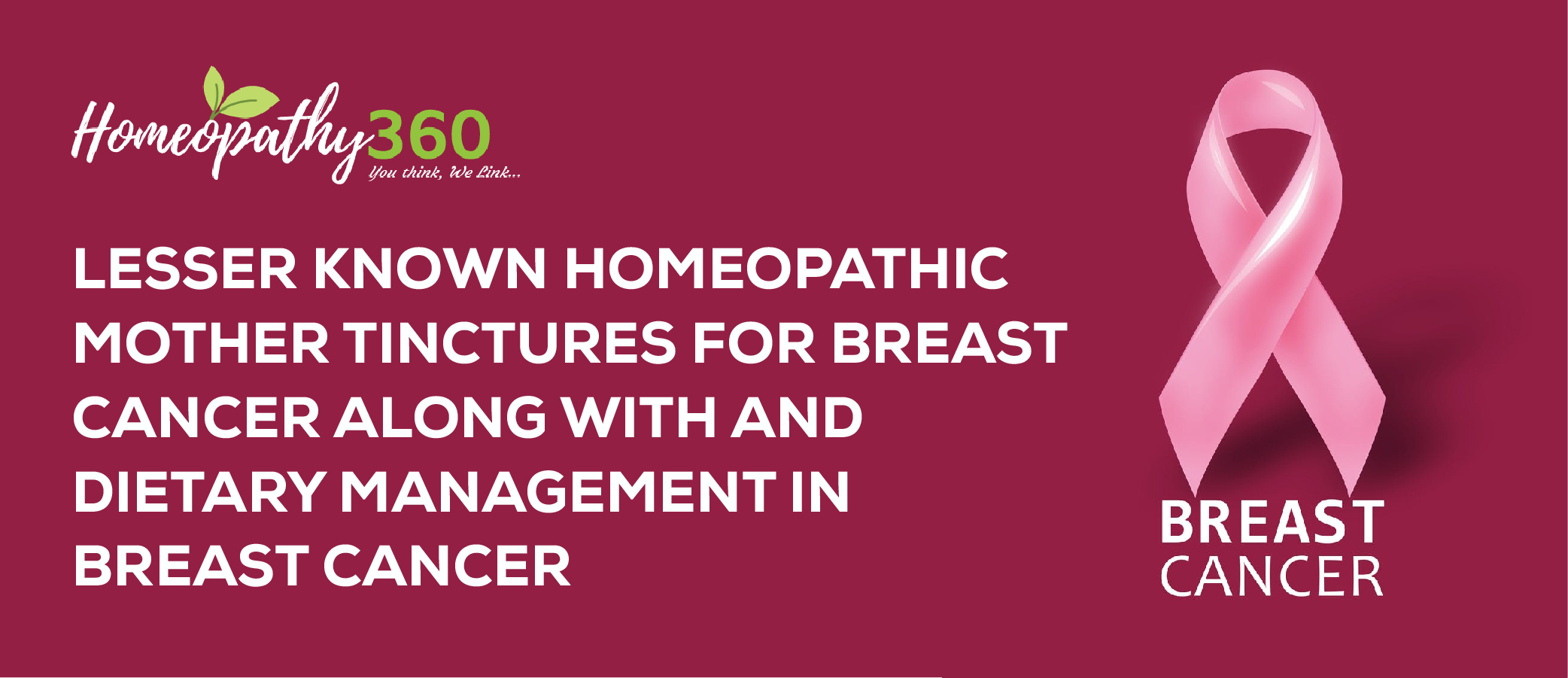
Breast cancer is one of the commonest malignancies affecting women in the world nowadays. It is likely to become a major public health issue in future. Mastectomy has its own limitations, risks and post-operative complications, therefore an alternative system of medicine, i.e. homoeopathic management as well as dietary management play an important role in treating cases of breast cancer.
KEYWORDS: CA breast, homoeopathy, mother tincture, remedy, diet and regimen.
ABBREVIATIONS: CA – carcinoma.
INTRODUCTION
Cancer of breast is one of the most common causes of death in middle aged females, in western countries. One in 12 women will develop the disease during their life period. Infact, it is the second most common cause of death due to carcinoma. The uncontrolled mutation of the cells leads to proliferation. Mostly, the cancer originates in lobules/ducts of the breast or in the adipose tissue of breast.
PATHOPHYSIOLOGY
There are trillions of cells present within the body which regulate the cell cycle that controls their growth, maturity, division, and death. During childhood, normal cells divide faster to permit the person to grow. Once adulthood is reached, the cells divide to exchange worn-out cells as well as repair injuries. They have longer life span and grow and form new, abnormal cells, instead of dying which are responsible for the development of carcinoma in lungs, stomach, breast, brain, spinal cord, etc. Breast carcinoma may arise from the lactiferous ducts (ductal carcinoma), or arise from lobules (lobular carcinoma) which is 10% common. Other carcinomas include ductal carcinoma in-situ, lobular carcinoma-in-situ. invasive carcinoma, etc.(1,2)
RISK FACTORS:
Geographically, it is common in western world as approximately 3 to 5 % of all deaths in women occur due to developing carcinoma. It is more common among 35 to 75 years of age, in females. The chances of occurrence are 0.5 %.. Other risk factors include previous radiation, hereditary factors, proliferative lesions, etc.(1,2)
- Being female
- Age
- Personal history
- Family history
- Radiation exposure
- Menarche at a younger age
- Beginning menopause at an older age
- First child at an older age
- Having never been pregnant
- Post-menopausal hormone therapy
- Alcohol.(1,2)
CLINICAL PRESENTATION:
Symptoms for breast cancer include:
(1,2)
• A breast lump or
tissue thickening developed shortly
• Breast pain
• Red, pitted skin
• Swelling altogether or from
a part of breast
• Nipple discharge instead of breast milk
• Bbloody discharge
from nipples
• Ppeeling, scaling, or
flaking of nipple/breast’s skin.
• Sudden, unexplained change within the shape
or size of breast
• Iinverted nipples
• Lump or swelling under arm.
(1,2)
TYPES:
The three most common types of breast cancer, which include:(1,2)
- Ductal carcinoma in-situ.
- Invasive ductal carcinoma.
- Invasive lobular carcinoma.(1,2)
Other rare types of breast cancer include:
- Paget’s disease of nipple.
- Phyllodes tumour.
- Angiosarcoma.
HOMEOPATHIC MANAGEMENT:
1) Conium maculatum Q
For hardness of mammary glands, when the surrounding region is hard, nodular, and tender to touch. Skin over the tumour is adherent. Helpful in cases of breast cancer beginning from duct which then invades the parenchyma (scirrhous adenocarcinoma), sometimes associated with the inflammation of breast tissue.(3,4,5)
Characteristic of pain is burning, stinging, piercing pain which becomes worse at night. Breast is painful even to touch of clothes or jar of walking. For discharge of pus from nipples, hard, cartilaginous lesions, when edges are irregular with productive fibrosis.(3,4,5)
2) Phytolacca decandra Q
For mastitis, ulcers and cracks around nipples, pain which radiates over whole body. Helpful in cases of breast tumour with enlargement of axillary glands, painful breast with hard and purple hue, as hard as of cheese. For persons who are very indifferent to life, or suffered from loss of personal delicacy and disregard of surrounding object. For irritable breasts before and after menses. Discharge of pus, foetid and unhealthy in character.
3) Thuja occidentalis Q
Used well in persons of lymphatic temperament, having dark complexion and unhealthy skin. Sensation as if there is something alive in abdomen, music causes trembling and weeping. For pustular discharge from breasts having acrid, musty, foul and sweetish odour. Suited to persons with hydrogenous or lymphatic constitution. For tearing and stitching pain in mammary glands as if they were being torn into pieces, with retracted nipples, which easily bleed. For ulcers which become flat with sunken apices.
4) Carcinosinum Q
Useful in cases of carcinoma of mammary glands with great pain and induration of glands, when the discharge becomes haemorrhagic and offensive with pain.
5) Pulsatilla nigricans Q
For thick, bland, and yellowish-green discharges. Especially useful for persons with mild, gentle, yielding disposition, crying readily, suffering from metastasis to mammae. For drawing, tearing, erratic pain with constant chilliness. For sore, aching mammary glands, lumps in girls before puberty, swollen breasts after weaning, when thick, milky fluid escapes from mammary gland.(3,4,5)
6) Hydrastis canadensis Q
For tumour of breast, retracted, sore, cracked nipples, with unhealthy skin, ulcers, or even cancerous formation. For thick, viscid, yellowish and ropy secretions. Hard tumours, which adhere to skin, with sharp, cutting and knife-like pain. Pain in breast on sneezing.
7) Iodum Q
In cases of nodosities over skin of mammae with black points, for mammae dwindling away, flabby, and ulceration of mammary glands. Wedge-like pain with enlargement of mammary lymph nodes. Persons with suicidal tendency. Sterility from atrophy of mammae, mammae heavy, as if would fall. Mammary glands swollen, hard, heavy, too hot always, with great debility, the slightest effort induces perspiration. All secretions of body remain salty, hot, acrid, watery or persistent. Feels well only while eating.(3,4,5)
8) Calcarea fluorica Q
For enlarged mammary glands with stony hardness. Knots, kernels, and hardened glands. Induration of stony hardness, threatening suppuration. Crack/fissure and hard skin, fistulous ulcer, with thick, yellow pustular discharge. Hard, elevated edges of ulcer, surrounded by swollen and purple skin.(3,4,5)
9) Baryta carbonicum Q
Fundamental pathogenesis of this drug is inflammation, induration.
For dwindling of mammary gland. Enlargement of the glands which is hard and stony in nature, and very sensitive to touch. Too tired even to eat. Pain in axillary glands, painful when walking. Bloody nipple discharge and the most commonly found tumour is solitary or occasionally be multiple.(3,4,5)
Dietary management of breast carcinoma:
Nutritional support to cancer patients does not increase their response to surgery, radiotherapy and chemotherapy, nor increased the length of their survival. A study at the National Institute of Health, USA, showed that intravenous feeding did not improve the survival or complication rates in patients. Cancer patients have altered metabolism and the benefit of nutrition is not observed as much as in a non-cancer patient. Routine intravenous feeding is strongly discouraged. Oral feeding or peripheral vein nutrition are more commonly used. Central parenteral nutrition is advised only if essential. Oral diet amplified with nutrient supplement for increased protein, calories, vitamins and minerals, enteral tube feeding, parenteral nutrition through central and peripheral veins may also be advised. Salivary gland secretions are commonly affected by carcinoma therapy, so liquid diet must be used. Sore mouth often results from chemotherapy or radiation to the head and neck area. Frequent small meals and snacks, soft in texture, bland in nature, and cool to cold in temperature are often better tolerated.(6,7)
CONCLUSION:
Homoeopathic treatment along with dietary management prove to be effective in the treatment of breast carcinoma. Disappearance of the signs and symptoms within a short span of time with the help of homeopathic mother tinctures and dietary management indicates the positive effect of homoeopathy in the treatment of breast cancer.
REFERENCES:
- Das S., A Concise Textbook of Surgery, 5th edition, Dr.S.Das, 2008, Page.No.712-738.
- Das S., A Manual On Clinical Surgery, 8th edition, Dr.S. Das, 2010,Page.No.419-422.
- Boericke W.,Pocket manual of homoeopathic material medica and repertory,9th edition,San Francisco,B.Jain Publishers Pvt.Ltd.,1927,Page.No.514-516, 230-232, 643-645, 179, 536-539, 106-108, 149-151, 349-354, 332-334.
- Phatak SR., Materia medica of homeopathic medicines, 2nd edition revised and enlarged, B.Jain publishers Pvt.Ltd, 1999, Page.No.558-561, 255-260, 708-712, 581-587, 108-111, 157-159, 364-368, 349-351.
- Allen HC., Keynotes and characteristics with comparison’s and Bowel Nosodes, 2nd edition, Mayur jain Indian Books And Periodicals Publishers, 2007, Page.No.202, 92-94, 266-269, 212-214, 123.
- Shrilakshmi B,Dietetics,8thmulti-colouredition,Newageinternational(P)Ltd.,2019,PageNo.494-495.
- Antia FP & Abraham P,Clinical Dietetics and Nutrition, 4thedition, Page.No.442.
About Author:
Dr Farnaz M Memon
BHMS,MSc.Forensic Sciences
Consultant Homeopath at Naz Homeopathic Clinic, Vadodara,Gujarat





